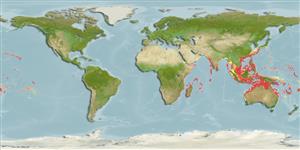Environment / Climate / Range
Ecology
Marine; brackish; demersal; depth range 10 - 110 m (Ref. 12260). Tropical; 26°C - 29°C, preferred ?; 35°N - 36°S, 19°E - 137°W
Indo-Pacific: Red Sea and the east African coast (30° to about 50°S) to Australia and Tahiti, north to the Ryukyu Islands (Ref. 27956).
Size / Weight / Age
Maturity: Lm ? range ? - ? cm
Max length : 21.0 cm FL male/unsexed; (Ref. 5525); common length : 15.0 cm TL male/unsexed; (Ref. 5450)
Found in shallow inshore coastal waters over silty bottoms (Ref. 30573, 90102). Young enters mangrove estuaries or silty reef areas (Ref. 4833, 90102). Searches for prey using a protruding pipette-like mouth or by sieving potential food through their gill rakers (Ref. 26569). Feeds on small fishes, shrimps, other crustaceans, and polychaetes. Sold fresh and dried salted; also made into fishmeal.
Life cycle and mating behavior
Maturity | Reproduction | Spawning | Eggs | Fecundity | Larvae
James, P.S.B.R., 1984. Leiognathidae. In W. Fischer and G. Bianchi (eds.) FAO species identification sheets for fishery purposes. Western Indian Ocean (Fishing Area 51). Vol. 2. FAO, Rome. pag. var. (Ref. 3424)
IUCN Red List Status (Ref. 115185)
CITES (Ref. 94142)
Not Evaluated
Threat to humans
Harmless
Human uses
Fisheries: commercial
Tools
Special reports
Download XML
Internet sources
